11 Types of Sprinklers for Your Lawn & Garden (With Pictures)
-

- Last updated:
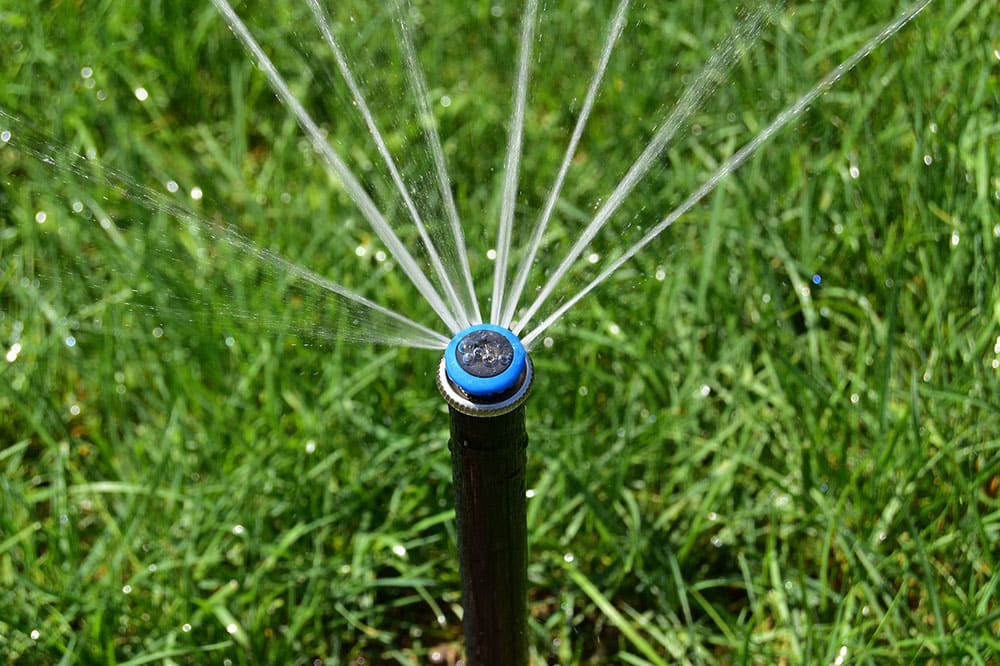
If you own a sprinkler system, it’s easy to overlook how much water you use to keep the lawn and garden looking fantastic.
By many estimates, Americans devote almost a third of the water they use every day to their irrigation systems. Of the nearly 9 billion gallons we collectively use every day, up to 50% of that is wasted on evaporation and runoff because of inefficient irrigation.
More efficient water usage helps the environment, your lawn, and your wallet. Much of that starts with eco-friendly practices, but you can make your efforts more convenient and successful with informed purchasing decisions. That all starts with your sprinkler systems.
There are all kinds of sprinklers for the lawn and garden, all with unique needs and benefits for different setups. Learn about the different types of sprinklers available today to save time, money, and water with your next installation.
The 11 Types of Sprinklers
1. Stationary Sprinklers
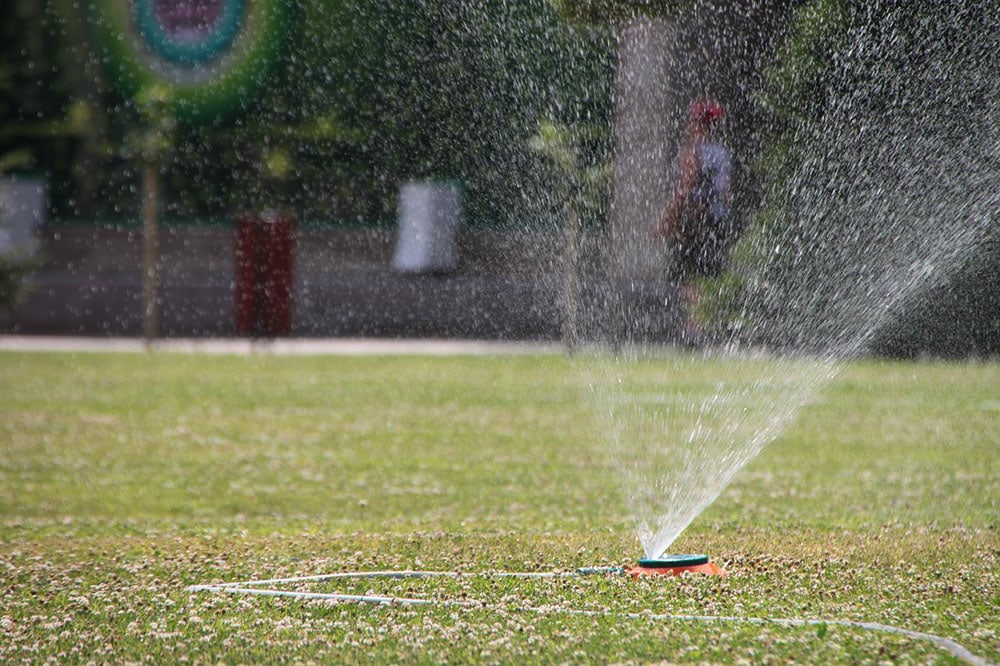
| Application: | Shrubs, small lawns |
| Spray Pattern: | Uni-directional, adjustable radius, circle |
Stationary sprinklers spray in a single, fixed pattern. There are no moving parts, so malfunctions are less likely than they are on rotary or oscillating styles.
These sprinklers come in various shapes to suit different lawn sizes and layouts.
Flat, disc-shaped sprinklers can sit in the middle of a circular lawn and spray water like a showerhead in a 360° pattern. Other sprinkler heads sit on a post and direct water in one direction, but you can often adjust and swap out nozzles to change the spray pattern.
Fixed patterns can range from straight, direct streams to semi- or half-circle fan-shaped sprays. These sprinklers are ideal for small lawns with straight sides, where you can place a sprinkler at the edge, adjust the radius, and blanket the entire area. They also work well for individual shrubs and long, narrow stretches.
Because they tend to spray more of a mist, stationary sprinklers are prone to waste from winds. They’re best for smaller applications where high winds are not an issue.
- Inexpensive
- Less prone to breakdown
- Good for small areas
- Fixed position
- Can form puddles
2. Multi-Stream Rotary Sprinklers

| Application: | Medium-large lawn, circular area |
| Spray Pattern: | Circle |
Propelled by the force of the water, rotary sprinklers spin in a circle to blanket an area in water. The rotating base has several arms with multiple jets to release streams of water. You can usually adjust the height of the sprayer or angle of the nozzles to change the coverage area, often between 10–50 feet.
Rotating sprinklers deliver water at a slower rate than fixed sprinklers, so they’re best for slow-draining soils like clay.
- Slow streams waste less water to wind than stationary sprinklers
- Good for larger lawn sizes
- Unlikely to form puddles
- Higher psi demands than stationary sprinklers
3. Gear-Driven Sprinklers
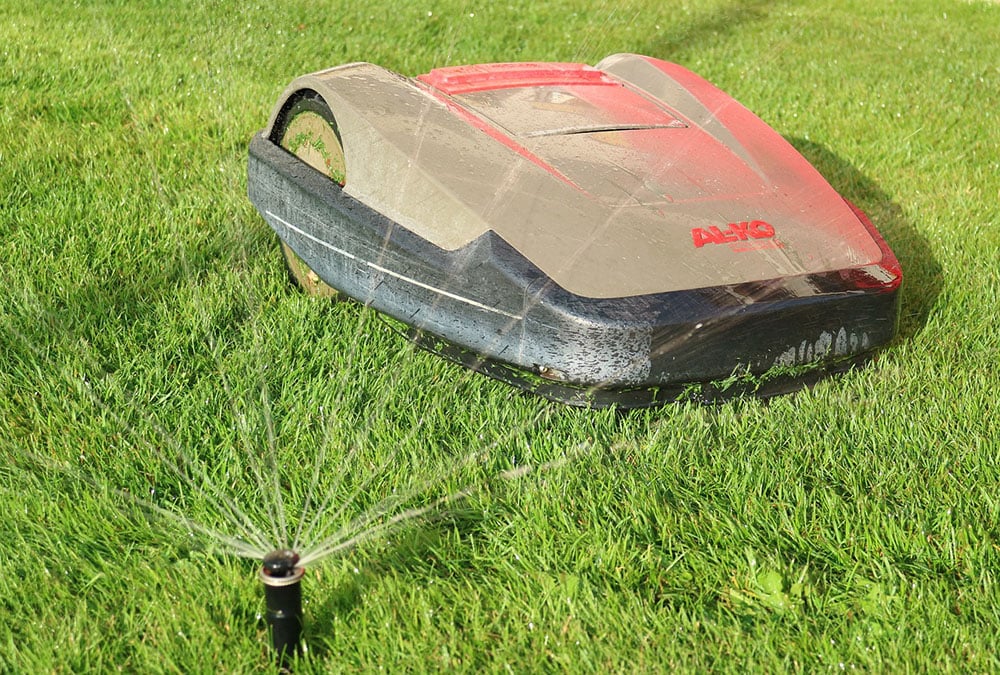
| Application: | Medium-large lawn, side yard |
| Spray Pattern: | Adjustable arc, circle |
A gear-driven sprinkler moves through gears powered by water flowing into it. Unlike multi-stream rotary sprinklers, gear-driven models do not have arms, looking more like stationary sprayers in many cases.
Many gear-driven sprinklers offer adjustable stream patterns or interchangeable nozzles. You can also fine-tune them to fit a specific watering range, usually anywhere between 40–360° in rotation.
These sprinklers can shoot water in a 10–40 foot radius. Much like multi-stream rotating sprinklers, they are best for compact soils and sloping areas.
- Enclosed bodies are less susceptible to debris damage
- Versatile, easy to adjust patterns and ranges
- Quiet operation
- Lower psi requirement
- Can be more expensive than multi-stream options
- Limited spray distance
4. Impact Sprinklers
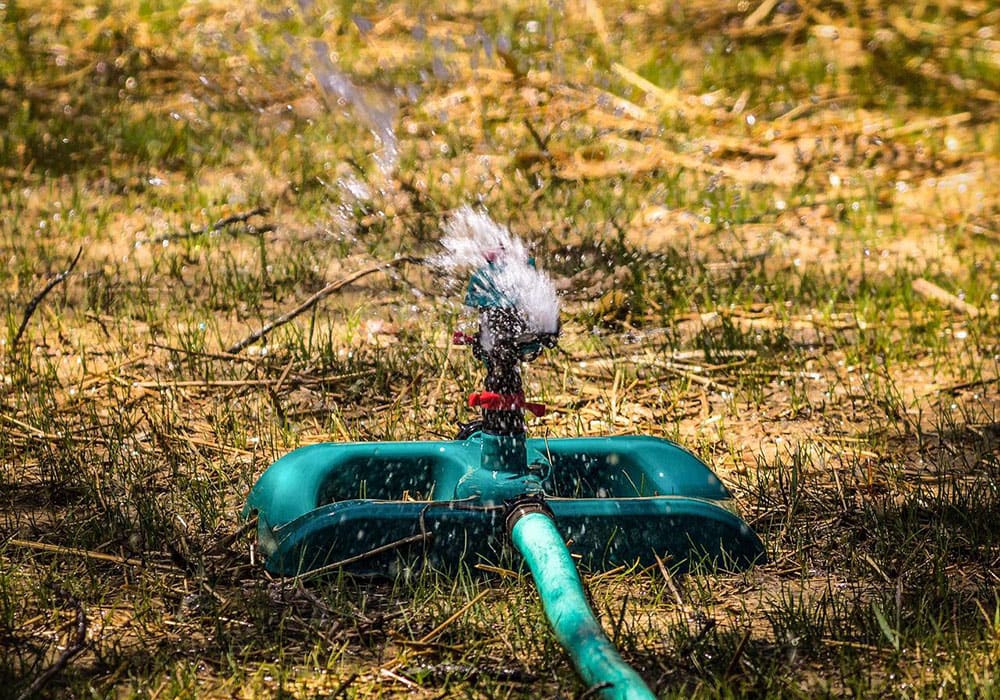
| Application: | Large lawns, commercial properties |
| Spray Pattern: | Adjustable arc, circle |
| Water Pressure Requirements: | 30-50 psi |
Impact sprinklers are the source of the sounds of summer, producing the familiar “chik-chik-chik” sound as they shoot jets of water in a slow arc. All of the mechanisms of these basic yet intelligent designs are on the body’s exterior. You can adjust the sprinkler to swing back and forth in an arc in various ranges, or you can open it up to spin continuously in a 360° circle.
An impact sprinkler is ideal for a large area because it throws water a far distance. There are a couple of simple adjustments—a movable flap and a screw—that you can use to obstruct the flow, thus changing the angle and distance of the sprinkler.
No matter how far or close you plan to water, the impact sprinkler’s jet stays powerful, so it is not practical for watering delicate gardens or recently seeded areas. Use it for large garden areas and established lawns instead.
- Long-lasting and low-maintenance
- Works with hard water
- Good coverage range
- High psi demands
- More expensive due to metal parts
5. Oscillating Sprinklers
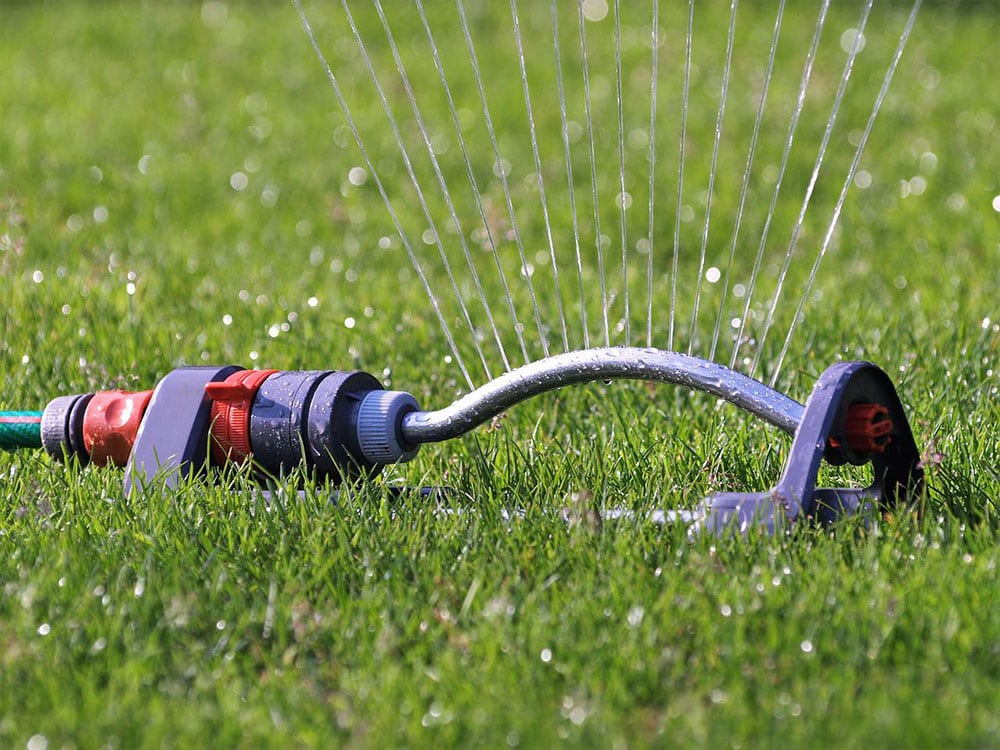
| Application: | Medium-large yards, square/rectangular area |
| Spray Pattern: | Rectangle |
An oscillating sprinkler features a horizontal tube with several holes down its length. The force of water flowing into it makes the sprinkler sway back and forth, streaming water from one side to the other in a square or rectangular pattern. You can adjust the range to make longer or shorter rectangular spreads, depending on the shape and size of your lawn.
It can take a bit of time for the pressure to build up before the oscillation starts. You may need to experiment to find the correct placement because the water pressure can impact the range. If the water pressure is too low, the sprinkler may not spray far enough to be effective. When it’s too high, you may water further than you want.
- Perfect for conventional rectangular lawns
- Fun for kids to play in
- Can be hard to adjust the range
- Some won’t work with poor water pressure
- You may end up with puddling
6. Pop-Up Sprinklers

| Application: | Small-large lawns |
| Spray Pattern: | Fixed |
Pop-up sprinklers sit underground until the water pressure from your activated irrigation system forces them to pop up and start spraying water. When the water pressure goes down, they sink back below the ground. Although they’re expensive to install relative to above-ground options, they’re efficient for homeowners who don’t plan to move anytime soon.
You can adjust heads to different spray patterns and ranges to fit your lawn size and shape, with most models reaching between 5–35 feet in radius. Because they work underground and don’t move, they make convenient solutions for long-term irrigation systems.
- Unlikely to be damaged by hazards
- Adjustable
- Difficult to move
- More expensive than many other options
7. Flood Bubblers
| Application: | Tree basins, planters, shrubs, ground cover |
| Spray Pattern: | Circle |
Rather than shoot out water, flood bubblers are pipes sticking up from the ground that erupt with water, overflowing to cover the immediate area around them, usually up to a 5-foot spread. These work well for plants that need a deep, targeted soak, such as trees and shrubs. Sprinklers have fixed heads, but you can turn them to adjust the flow rate at intervals between ¼–2 GPM.
Bubblers work best in well-draining soil because they disperse water quickly to a single area, hence the name “flood”. You will waste a lot of water on compacted or sloping soil, and it’s an impractical and potentially harmful means for watering vast areas of grass.
Use flood bubblers on standalone plants, such as young trees you’re trying to establish. They also work well on shrubs close to the house and other structures that you don’t want to hit with a sprinkler.
- Good for soaking deep root systems
- Targeted water use
- Impractical for large areas
- Wasted runoff on compacted soil or sloping areas
8. Micro Bubblers
| Application: | Flower beds |
| Spray Pattern: | Circle |
Micro-bubblers are sometimes known as drip emitters, but they work like flood bubblers for smaller areas around 2 feet wide. If you’re running drip tubing, these come equipped with barbs to attach them anywhere you need along the line.
Micro-bubblers have a low flow rate, around 4 gallons per hour. It’s much less than their larger counterparts and conventional sprinklers, but their small spread still means you’ll have ample watering in a short time.
- Work well on low pressure
- Adjustable flow
- Targeted water use
- Not ideal for large plants
9. Stream Bubblers
| Application: | Shrubs, flower beds, planters |
| Spray Pattern: | Fixed, adjustable arc, circle |
Stream bubblers are micro-sprinklers that dispense water in a short 2–5’ radius. They’re still prone to some flooding given their limited range, so you usually have to use them like other bubblers. Keep them on level, well-draining soil to avoid wasting water.
Micro-sprayers like these work for targeted applications like planters and flower gardens. They often sit on fixed posts out of the way so that nobody trips over them.
- Good for delicate plants
- Work well with low pressure
- May waste some water in runoff
10. Traveling Sprinklers
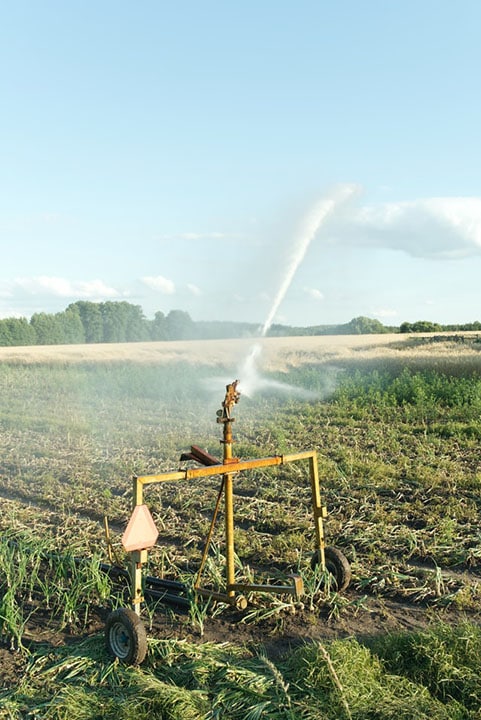
| Application: | Large yards, fields |
| Spray Pattern: | Rectangle |
Traveling sprinklers move across your yard spraying water. The force of the water moving through the hose pushes the sprinkler along its track. The sprinkler follows the hose back to its starting point, so you can lay it out in any path you want for an irregular-shaped lawn. An oscillating or rotary sprayer on the top of the sprinkler showers water all around the unit as it travels, ensuring a wide, even spread.
- Evenly covers large spaces
- Customizable paths to fit any lawn shape
- High psi demands
- Impractical for small areas
11. Sprinkler Hose

| Application: | Small lawn |
| Spray Pattern: | Variable |
A sprinkler hose is the only hand-operated option on this list, but it’s nonetheless a practical way to water a lawn or garden in many instances. If you have a long period of watering on a single spot, you can set the sprayer up and lock the handle so you don’t have to continue holding. You will have to make sure it’s set up in a sturdy position so that it doesn’t fall and waste water while you’re away from it.
- Adjustable spray settings
- Ensures efficient use of water
- Good for small lawns and infrequent watering needs
- Manual operation can be inconvenient
Additional Considerations
Your lawn shape and size are the first consideration when buying an appropriate sprinkler for your lawn. It’s better to use fewer sprinklers to reduce costs, water waste, and maintenance demands.
You should find a sprinkler that can cover your whole lawn or garden without hitting walkways, driveways, or your house. But before you spring for the first one that has the proper coverage, you have a few other factors to consider.
PSI (pounds per square inch)
If you have low water pressure, you won’t have enough power to operate certain sprinklers to their full potential. You will be unable to use some rotary sprayers, and traveling sprinklers would likely be completely out of the question. Fortunately, you can find many stationary, rotating, and oscillating models that work under 40 psi, but always check your home’s water pressure and the product specs before purchasing.
Automatic or Manual
For loads of extra convenience (and more money), you can buy automatic sprinklers that don’t rely on you to turn on. Many pop-up sprinklers, for instance, work on timers designed to start in the early morning hours when watering conditions are perfect. More advanced systems connect to the cloud to follow weather data, allowing them to start only when there have been periods without rain.
Conclusion
A well-watered lawn and garden will transform the curb appeal of your home and your overall enjoyment of your property. But as crucial as it is to keep your plants flourishing, it’s even more critical to take a conservation mindset in buying your sprinklers. Seeking the most efficient system for your lawn and garden will save you money and water without sacrificing gorgeous landscaping.
Featured Image Credit: BerniPB, Pixabay
Contents

